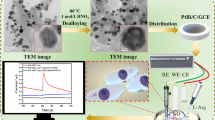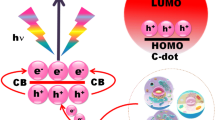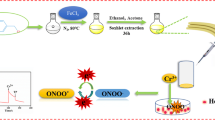Abstract
In this report 5,10,15,20-tetrakis(4-methoxyphenyl)porphyrin (H2TMPP) has been used as electrode material for an easy and direct detection of NO in cancer cells using different electrochemical techniques. Cyclic voltammograms of H2TMPP-modified GCE in aqueous electrolyte showed oxidation peaks at 0.5 and 0.73 V and reduction peak at 0.64 V and a small peak at 0.4 V which are attributed to the redox processes of the system. The anodic and cathodic peak currents were proportional to the square root of the scan rate indicating a diffusion controlled mechanism. The H2TMPP-modified GC electrode exhibits a good stability after several circles. The fabricated electrode system was used to probe the concentration change of NO in HeLa cells using chronoamperometry. The NO sensor registered an amperometric current sensitivity of 0.0138 nA/μL with a linear correlation coefficient of 0.99571 in the presence of extracellular NO released upon activation of HeLa cells. Via confocal laser scanning microscopy, it has been demonstrated that H2TMPP could be used as a fluorescent indicator for cell imaging.









Similar content being viewed by others
References
Castillo J, Isik S, Blöchl A, Rodrigues NP, Bedioui F, Csöregi E, Schuhmann W, Oni J (2005) Simultaneous detection of the release of glutamate and nitric oxide from adherently growing cells using an array of glutamate and nitric oxide selective electrodes. Biosens Bioelectron 20:1559–1565
Rodrigues NP, Bedioui F, Deutsch A, Zurgil N, Afrimzon E, Shafran Y, Deutsch M (2006) Construction and use of an integrated electrochemical device for the detection of biologically relevant compounds released from non-adherent cells: Application for the electrochemical determination of nitric oxide produced by human U937 cells. Electrochem Commun 8:341–347
Ignarro LJ (ed) (2000) Nitric oxide biology and pathology. Academic, San Diego, Reviews
Lancaster J (ed) (1996) Nitric oxide principles and actions. Academic Press, San Diego
Griveau S, Dumézy C, Séguin J, Chabot GG, Scheman D, Bedioui F (2007) In vivo electrochemical detection of nitric oxide in tumor-bearing mice. Anal Chem 79:1030–1033
Bedioui F, Villeneuve N (2003) Electrochemical nitric oxide sensors for biological samples-Principle, selected examples and applications. Electroanalysis 15:5–18
Li C-Z, Alwarappan S, Zhang W, Scafa N, Zhang X (2009) Metallo protoporphyrin functionalized microelectrodes for electrocatalytic sensing of nitric oxide. Amer J Biomed Sci 1:274–282
Wang S, Lin X (2005) Electrodeposition of Pt-Fe(III) nanoparticle on glassy carbon electrode for electrochemical nitric oxide sensor. Electrochim Acta 50:2887–2891
Wartelle C, Schuhmann W, Blöchl A, Bedioui F (2005) Integrated compact biocompatible hydrogel-based amperometric sensing device for easy screening of drugs involved in nitric oxide production by adherent cultured cells. Electrochim Acta 50:4988–4994
Pontié M, Gobin C, Pauporté T, Bedioui F, Devynck J (2000) Electrochemical nitric oxide microsensors: Sensitivity and selectivity characterization. Anal Chim Acta 411:175–185
Peng YF, Hu CH, Zheng DY, Hu SS (2008) A sensitive nitric oxide microsensor based on PBPB composite film modified carbon fiber microelectrode. Sens Actuat B: Chem 133:571–576
Chen X, **e P, Tian Q, Hu S (2006) Amperometric nitric oxide sensor based on poly(thionine)/nafion-modified electrode and its application in monitoring nitric oxide release from rat kidney. Anal Lett 39:1321–1332
Biesaga M, Pyrzynska K, Trojanowicz M (2000) Porphyrins in analytical chemistry—a review. Talanta 51:209–224
Temelli B, Unaleroglu C (2009) Synthesis of meso-teraphenyl porphyrins via condensation of dipyrromethanes with N-tosyl imines. Tetrahedron 65:2043–2050
Tanaka M, Hayashi S, Eu S, Umeyama T, Matano Y, Imahori H (2007) Novel unsymmetrically π-elongated porphyrin for dye-sensitized TiO2 cells. Chem Commun 2069–2071
Mozer AJ, Griffith MJ, Tsekouras G, Wagner P, Wallace GG, Mori S, Sunahara K, Miyashita M, Earles JC, Gordon KC, Du L, Katoh R, Furube A, Officer DL (2009) Zn-Zn porphyrin dimer-sensitized solar cells: Toward 3-D light harvesting. J Am Chem Soc 131:15621–15623
Rochford J, Chu D, Hagfeldt A, Galoppini E (2007) Tetrachelate porphyrin chromophores for metal oxide semiconductor sensitization: Effect of the spacer length and anchoring group position. J Am Chem Soc 129:4655–4665
Ogawa K, Zhang T, Yoshihara K, Kobuke Y (2002) Large third-order optical nonlinearity of self-assembled porphyrin oligomers. J Am Chem Soc 124:22–23
Screen TEO, Thorne JRG, Denning RG, Bucknall DG, Anderson HL (2002) Amplified optical nonlinearity in a self-assembled double-strand conjugated porphyrin polymer ladder. J Am Chem Soc 124:9712–9713
Fukuzumi S, Imahori H, Yamada H, El-Khouly ME, Fujitsuka M, Ito O, Guldi DM (2001) Catalytic effects of dioxygen on intramolecular electron transfer in radical ion pairs of zinc porphyrin-linked fullerenes. J Am Chem Soc 123:2571–2575
Kang Y, Kampf JW, Meyerhoff ME (2007) Optical fluoride sensor based on monomer-dimer equilibrium of scandium(III)-octaethylporphyrin in a plasticized polymeric film. Anal Chim Acta 598:295–303
Vlasici D, Pruneanu S, Olenic L, Pogacean F, Ostafe V, Chiriac V, Pica EM, Bolundut LC, Nica L, Fagadar-Cosma E (2010) Manganese(III) porphyrin-based potentiometric sensors for diclofenac assay in pharmaceutical preparations. Sensors 10:8850–8864
Macdonald IJ, Dougherty TJ (2001) Basic principles of photodynamic therapy. J Porphyrins Phthalocyanines 5:105–129
Banfi S, Caruso E, Caprioli S, Mazzagatti L, Canti G, Ravizza R, Gariboldi M, Monti E (2004) Photodynamic effects of porphyrin and chlorin photosensitizers in human colon adenocarcinoma cells. Bioorg Med Chem 12:4853–4860
Dudkowiak A, Teslak E, Habdas J (2006) Photophysical studies of tetratolylporphyrin photosensitizers for potential medical applications. J Mol Struct 792–793:93–98
Josefsen LB, Boyle RW (2008) Photodynamic therapy: novel third-generation photosensitizers one step closer? British J Pharma 154:1–3
Ryabova V, Schulte A, Erichsen T, Schuhmann W (2005) Robotic sequential analysis of library of metalloporphyrins as electrocatalysts for voltammetric nitric oxide sensors. Analyst 130:1245–1252
Diab N, Oni J, Schulte A, Radtke I, Blöchl A, Schuhmann W (2003) Pyrrole functionalised metalloporphyrins as electrocatalysts for oxidation of nitric oxide. Talanta 61:43–51
Diab N, Schuhmann W (2001) Electropolymerized manganese porphyrin/polypyrrole films as catalytic surfaces for the oxidation of nitric oxide. Electrochim Acta 47:265–273
Bedioui F, Trevin S, Albin V, Villegas MGG, Devynck J (1997) Design and characterization of chemically modified electrodes with iron(III) porphyrinic-based polymers: Study of their reactivity toward nitrites and nitric oxide in aqueous solution. Anal Chim Acta 341:177–185
Malinski T, Taha Z (1992) Nitric oxide release from a single cell measured in situ by a porphyrinic-based microsensor. Nature 358:676–678
Gottlieb HE, Kotlyar V, Nudelman A (1997) NMR chemical shifts of common laboratory solvents as trace impurities. J Org Chem 62:7512–7515
Gritzner G, Kuta J (1984) Recommendations on reporting electrode potentials in nonaqueous solvents. J Pure Appl Chem 56:461–466
Ruiz Aranzaes J, Daniel M-C, Astruc D (2006) Metallocenes as references for the determination of redox potentials by cyclic voltammetry permethylated iron and cobalt sandwich complexes, inhibition by polyamine dendrimers and the role of hydroxy-containing ferrocenes. Can J Chem 84:288–299
Nafady A, Geiger WE (2008) Characterization of the successive one-electron oxidation products of the dicobalt fulvalenediyl (Fv) compound Co2Fv(CO)4 and its phosphine-substituted product. Organometallics 27:5624–5631
Degl’Innocenti D, Marzocchini R, Rosati F, Cellini E, Raugei G, Ramponi G (1999) Acylphosphatase expression during macrophage differentiation and activation of U-937 cell line. Biochimie 81:1031–1035
Adler AD, Longo FR, Finarelli JD (1967) A simplified synthesis for meso-tetraphenylporphyrins. J Org Chem 32:476–477
LeSuer RJ, Buttolph C, Geiger WE (2004) Comparison of the conductivity properties of the tetrabutylammonium salt of tetrakis(pentafluorophenyl)borate anion with those of traditional supporting electrolyte anions in nonaqueous solvents. Anal Chem 76:6395–6401
Barrière F, Geiger WE (2006) Use of weakly coordinating anions to develop an integrated approach to the tuning of ΔE 1/2 values by medium effects. J Am Chem Soc 128:3980–3989
Gericke HJ, Barnard NI, Erasmus E, Swarts JC, Cook MJ, Aquino MAS (2010) Solvent and electrolyte effects in enhancing the identification of intramolecular electronic communication in a multi redox-active diruthenium tetraferrocenoate complex, a triple-sandwiched dicadmium phthalocyanine and a ruthenocenecontaining β-diketone. Inorg Chim Acta 363:2222–2232
Nemykin VN, Rohde GT, Barrett CD, Hadt RG, Sabin JR, Reina G, Galloni P, Floris B (2010) Long-range electronic communication in free-base meso-poly(ferrocenyl)-containing porphyrins. Inorg Chem 49:7497–7509
Hildebrandt A, Schaarschmidt D, Lang H (2011) Electronically intercommunicating iron centers in di- and tetraferrocenyl pyrroles. Organometallics 30:556–563
Hildebrandt A, Schaarschmidt D, Claus R, Lang H (2011) Influence of electron delocalization in heterocyclic core systems on the electrochemical communication in 2,5-Di- and 2,3,4,5-Tetraferrocenyl thiophenes, furans, and pyrroles. Inorg Chem 50:10623–10632
Miesel D, Hildebrandt A, Korb M, Low PJ, Lang H (2013) Synthesis and (spectro)electrochemical behavior of 2,5-diferrocenyl-1-phenyl‑1H‑phosphole. Organometallics 32:2993–3002
Speck JM, Claus R, Hildebrandt A, Rüffer T, Erasmus E, van As L, Swarts JC, Lang H (2012) Electron transfer studies on ferrocenylthiophenes: Synthesis, properties, and electrochemistry. Organometallics 31:6373–6380
Pfaff U, Hildebrandt A, Schaarschmidt D, Hahn T, Liebing S, Kortus J, Lang H (2012) Di- and triferrocenyl (hetero)aromatics: Synthesis, characterization, (spectro-)electrochemistry, and calculations. Organometallics 31:6761–6771
Hildebrandt A, Lang H (2011) Influencing the electronic interaction in diferrocenyl-1-phenyl-1H-pyrroles. Dalton Trans 40:11831–11837
Ni Y, Zhang X, Kokot S (2009) Spectrometric and voltammetric studies of the interaction between quercetin and bovine serum albumin using warfarin as site marker with the aid of chemometrices. Spectrochim Acta A 71:1865–1872
Feng L, Wu L, Wang J, Ren J, Miyoshi D, Sugimoto N, Qu X (2012) Detection of a prognostic indicator in early stage cancer using functionalized graphene based peptide sensor. Adv Mater 24:125–131
Wadsworth R, Stankevicius E, Simonsen U (2006) Physiologically relevant measurements of nitric oxide in cardiovascular research using electrochemical microsensors. J Vascular Res 43:70–85
Thomsen LL, Miles DW, Happerfield L, Bobrow LG, Knowles RG, Moncada S (1995) Nitric oxide synthase activity in human breast cancer. British J Cancer 72:41–44
Thomsen LL, Lawton FG, Knowles RG, Beesley JE, Moreno V-T, Moncada S (1994) Nitric oxide synthase activity in human gynecological cancer. Cancer Res 54:1352–1354
Lala PK, Chakraborty C (2001) Role of nitric oxide in carcinogenesis and tumor progression. Lancet Oncol 3:149–156
Trouillon R, Cheung C, Patil BA, O’Hare D (2010) Electrochemical study of the intracellular transduction of vascular endothelial growth factor induced nitric oxide synthase activity using a multi-channel biocompatible microelectrode array. Biochim Biophys Acta 1800:929–936
Koh WCA, Chandra P, Kim D-M, Shim Y-B (2011) Electropolymerized self-assembled layer on gold nanoparticles: Detection of inducible nitric oxide synthase in neuronal cell culture. Anal Chem 83:6177–6183
Pailleret A, Oni J, Reiter S, Isik S, Etienne M, Bedioui F, Schuhmann W (2003) Scanning electrochemical microscopy assisted positioning of NO-specific amperometric sensors above human umbilical vein endothelial cells for the electrochemical detection of nitric oxide release. Electrochem Commun 5:847–852
Kikugawa K, Oikawa N, Miyazawa A, Shindo K, Kato T (2005) Interaction of nitric oxide with glutathione or cysteine generates reactive oxygen species causing DNA single strand breaks. Bio Pharma Bull 28:998–1003
Acknowledgments
We are grateful to the Deutsche Forschungsgemeinschaft DFG (Research Unit 1154 “Towards Molecular Spintronics“) and the Fonds der Chemischen Industrie (FCI) for generous financial support. SC thanks Alexander von Humboldt foundation and Department of Science and Technology, Government of India for providing Humboldt Fellowship and Women scientist award, respectively.
Author information
Authors and Affiliations
Corresponding authors
Rights and permissions
About this article
Cite this article
Chandra, S., Mende, C., Bahadur, D. et al. Fabrication of a porphyrin-based electrochemical biosensor for detection of nitric oxide released by cancer cells. J Solid State Electrochem 19, 169–177 (2015). https://doi.org/10.1007/s10008-014-2583-z
Received:
Revised:
Accepted:
Published:
Issue Date:
DOI: https://doi.org/10.1007/s10008-014-2583-z




